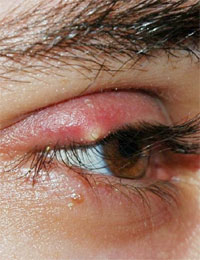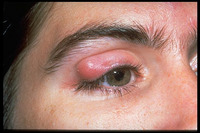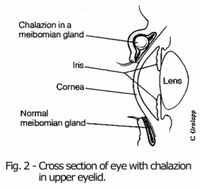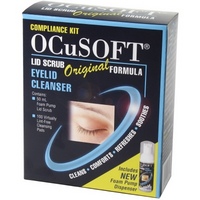Is That a Stye I Spy in Your Eye?
Styes and chalazions are two common “bumps” that form in the eyelids. A stye is an infection of a gland or hair follicle. It can also be called a hordeolum. A chalazion is not an infection, but results from a blockage of a meibomian gland. Meibomian glands are found along the edge of the upper and lower eyelids and they secrete oils into the tear film.

A stye is an infection in an eyelid gland or hair follicle.
www.eyehelp.com
Styes start as a red, tender, swollen spot near the edge of the eyelid. They develop into a bump that resembles a pimple. Sometimes the swelling and tenderness is localized to a small area of the eyelid, but the entire lid can be affected. Styes can also cause tearing and light sensitivity. Staphylococcal bacterial, which are part of the normal flora in the eye, cause most styes.

Large chalazion
www.eyemac.com

A chalazion is the result of a blocked meibomian gland.
Toronto Eye Clinic
A chalazion resembles a stye but is not caused by bacteria. A blockage traps the oil of a meibomian gland in the lid forming a small bump. Most chalazia are about the size of a pea and occur further from the lid margin than a stye. They are usually painless. Treatments for styes and chalazia are similar. Rarely, these conditions will resolve on their own in 1-2 weeks without any treatment. However, the healing process can be hastened by applying hot compresses to the eyelids 3-4 times per day. A clean washcloth is moistened with hot water and then applied to the closed eyelid for 10-15 minutes. The cloth should be remoistened to keep it hot. The heat and pressure will cause the stye to come to a head and drain like a pimple and then it will heal. For persistent styes an optometrist may prescribe antibiotic drops or ointments. A stye should never be “popped” because it could cause the infection to spread throughout the eyelid. Chalazia are also treated using hot compresses. They generally take longer than styes to resolve, sometimes 1-2 months. Antibiotics are not effective since an infection is not present. Chalazia that do not respond to hot compresses may be treated with steroid injections into the eyelid. Some chalazia require surgical excision.

An example of a commercially available lid scrub.

Dr. Jamie Barnes is an associate doctor at Bennett Optometry, with two offices in Ann Arbor. Contact her at bennettoptometry@gmail.com. Please visit our website http://www.bennettoptometry.com

